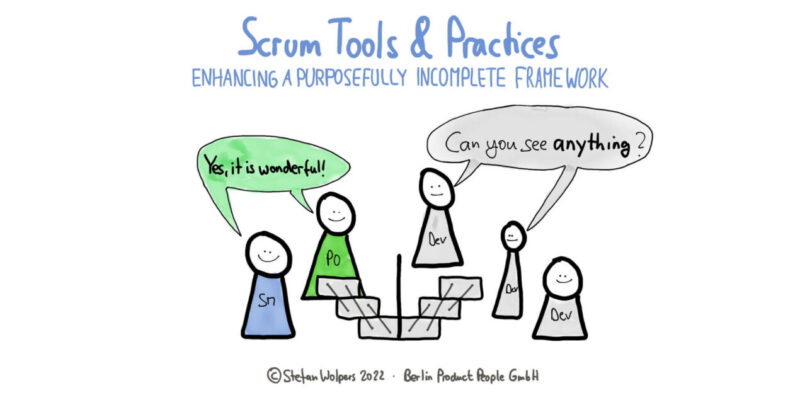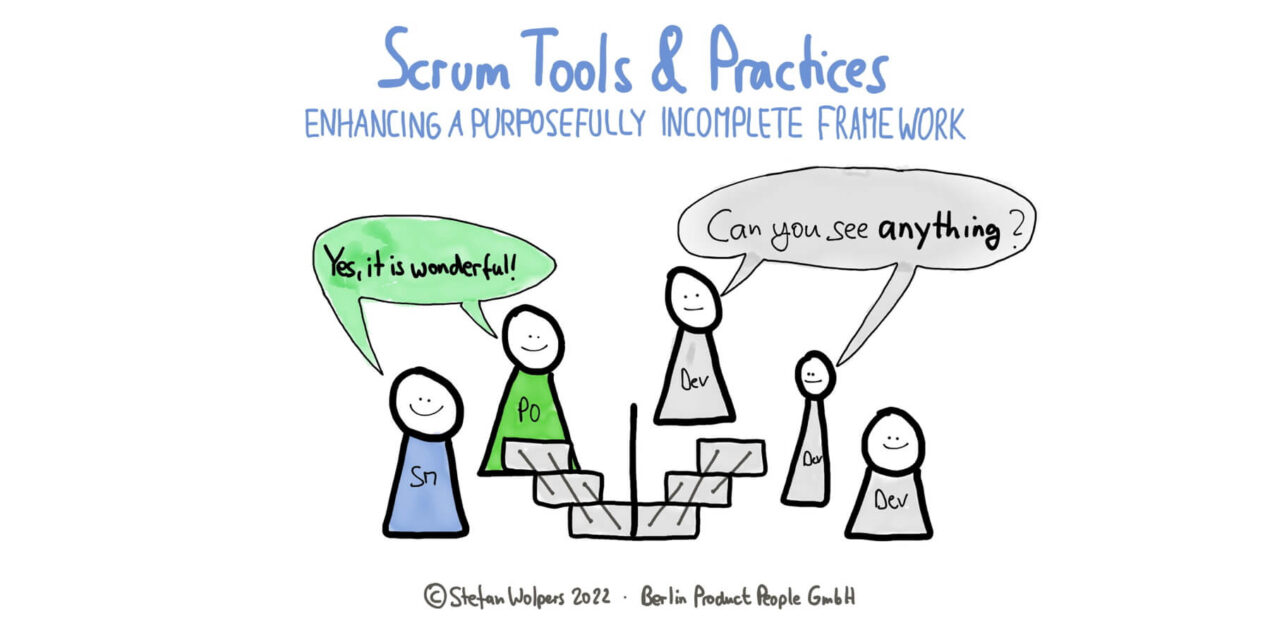TL; DR: Scrum Tools, Part 1
“The Scrum framework is purposefully incomplete, […].” (Source.) This half-sentence is probably one of the more often misinterpreted statements of the Scrum Guide. On the one side, it defines the necessity to enhance Scrum with other practices and tools. On the other side, it is the reason that so many attempts to practice Scrum are simply botched, resulting in ScrumBut versions of epic diversity. So, let’s look at proven Scrum tools and practices enhancing a purposefully incomplete framework without defying or negating its first principles.
Please note that the following Scrum tools and practices list is not complete. Please feel free to add more suggestions by commenting.
🇩🇪 Zur deutschsprachigen Version des Artikels: Scrum Werkzeuge und Praktiken zur Verbesserung eines unvollständigen Frameworks, Teil 1.
🗳 Update: Join the poll and its lively discussion on LinkedIn.
🗞 Shall I notify you about articles like this one? Awesome! You can sign up here for the ‘Food for Agile Thought’ newsletter and join 36,000-plus other subscribers.
🎓 Join Stefan in one of his upcoming Professional Scrum training classes!
🖥 💯 🇬🇧 Advanced Professional Scrum Master Online Training w/ PSM II Certificate — December 12-13, 2022.
📅 💯 🇬🇧 December 7, 2022: Join 150-plus peers at the 48th Hands-on Agile Meetup: Hands-on Agile 48: How Elon Musk Would Run YOUR Business with Joe Justice.
Different Areas of Applying Additional Scrum Tools and Practices
There are at least six areas where enhancing Scrum helps enable business agility. Part one of this three-part series will address stakeholder collaboration and team building:
Collaboration with Stakeholders
This section covers a lot of ground, given that the Scrum Guide addresses one self-managing team building one product. However, the reality is much different, particularly in large organizations. Helpful Scrum tools, concepts, and practices are, for example:
- Complexity: Scrum is not a one-size-fits-all approach to solving any problem. Scrum thrives at solving complex adaptive problems and fails at others. Use concepts like the Cynefin framework or the Stacey matrix to better understand appropriate decision processes and areas where Scrum might prove helpful.
- Organizational design: Think in team topologies or consider Conway’s law when organizational structures impede your organization’s progress towards using Scrum and becoming agile.
- Collaboration: Inclusion and alignment with stakeholders to build trust prove critical to a Scrum team’s success. Liberating Structures have repeatedly demonstrated that they help accomplish this goal. Other helpful practices are stakeholder retrospectives or the equivalent of lean manufacturing’s Gemba walks.
- Change: Not everyone in the organization will be excited to become agile. Typically, several members are vested in preserving the status quo for personal reasons. Lean Change Management can help understand why that is and how to make progress anyway.
- Empathy Mapping: Try walking in the shoes of your stakeholders to create a shared understanding of their needs that helps decision-making with Empathy Mapping.
- Stakeholder mapping: Not all stakeholders are created equal. Identify those the Scrum team needs to keep close.
- Responsibilities: Self-management does not entail that Scrum teams prepare their paychecks. Therefore, figure out who is responsible for what and at what level in collaboration with your management and other stakeholders. For example, Management 3.0’s Delegation Poker has proven to be a helpful tool for accomplishing this task.
Team Building
A “team” is not a group of people in the same place at the same time with a shared intent. Team building requires effort and engagement; you do not start with a Scrum team; you build one over time. The following enhancing Scrum tools and practices will support that effort:
- Team development: No effort can “roll out agility” to an organization. A shift in mindset is always a process that may consume months and years. The Agile Fluency Model® helps with understanding the principle forces at work at the team level. Also, consider the Tuckman stages and the Shu-Ha-Ri concept of mastering a craft.
- Self-selection of Scrum teams: Self-management in Scrum starts with teams selecting themselves. Closely related is the idea of peer recruiting that empowers a Scrum team to veto new hires. Advanced Scrum teams may also embrace dynamic reteaming.
- Working agreements: While the Scrum Guide provides Scrum Values at a relatively abstract level, creating concrete working agreements at the team level helps identify the team’s way of working within the given constraints. Consider enhancing this approach with the ReadMes of every team member.
- Coaching: Scrum cannot be pushed; it needs to be pulled, and coaching individual team members is a critical part of the process. Next to other techniques from the coaching toolbox, 1-on-1s with team members are particularly helpful.
- Psychological safety: Creating a safe environment where every team member can voice their opinion without fearing repercussions is critical for self-management. It creates trust and allows the Scrum team to inspect and adapt its way of working. Besides Scrum Values, non-violent communication and Core Protocols will support the process of creating psychological safety.
- Health checks: Have regular health checks as a Scrum team. There are various tools available to provide these self-inspection opportunities. However, you can start by running anonymous surveys among the team members. (Don’t forget to ask whether team members are happy with their situation, whether they would suggest an opening in your organization to a good friend, or whether they are already looking for a new job. You will be surprised about the results.)
- Education: In a complex environment, there are no experts. Therefore, continuously educating the members of the Scrum team is mission-critical. Next to generous training and conference budgets, there are also less prominent ways of achieving knowledge sharing, from pair programming to community of practices, book clubs, and brown-bag sessions.
- Slack time: Another idea to improve value creation and team building is abandoning the industrial paradigm-driven idea of pushing the “resource utilization” to 100 percent or beyond. On the contrary, reserving 10-20 percent of a team’s time to the unforeseeable improves the flow and, thus, effectiveness.
- Shared goals: In Scrum, Sprint Goals and Product Goals serve as unifying objectives out of the box. There are other means to extend this, for example, with OKRs or objectives and key results.
- Team events: Scrum is good at scoring match points. This is why we work as a team in Sprints and rally around a Sprint Goal. Beyond that work-related “team event,” there are numerous opportunities as a team to come together and accomplish something meaning full, from Hackathons to organizing Meetup sessions or company-wide Barcamps to celebrating successes such as achieving Sprint or Product Goals.
Conclusion
A purposefully incomplete framework is a blessing—and a curse in disguise. On the one side, it defines the necessity to enhance Scrum with other practices and tools. On the other side, it is the reason that so many attempts to practice Scrum are simply botched, resulting in ScrumBut versions of epic diversity. The necessity to look beyond the Scrum Guide to make Scrum successful also challenges many team members and organizations alike. Scrum Masters need to become comfortable addressing individual and organizational problems as their primary objective, Product Owners need to delve into product discovery, and Developers need to warm up to talking to customers. The opportunities to create something outstanding are endless; don’t get stuck in Scrum tool analysis paralysis.
Please note that this Scrum tools and practices list is not—and cannot be—complete. Please feel free to add more suggestions by commenting.
📖 Recommended Articles
Regarding Scrum tools, I recommend the following literature:
Scrum’s Nature: It Is a Tool; It Is Not About Love or Hate
Download the free Scrum Anti-Patterns Guide.
Download the free Scrum Guide 2020 Reordered to understand patterns.
Download the 73 Scrum Master Interview Questions for free.
📅 Scrum Training Classes, Workshops, and Events
Delve into understand Scrum with our Scrum training classes, workshops, and events. You can secure your seat directly by following the corresponding link in the table below:
See all upcoming classes here.
You can book your seat for the training directly by following the corresponding links to the ticket shop. If the procurement process of your organization requires a different purchasing process, please contact Berlin Product People GmbH directly.
✋ Learn More About Scrum Tools — Join the 12,000-plus Strong ‘Hands-on Agile’ Slack Community
I invite you to join the “Hands-on Agile” Slack Community and enjoy the benefits of a fast-growing, vibrant community of agile practitioners from around the world.
If you like to join all you have to do now is provide your credentials via this Google form, and I will sign you up. By the way, it’s free.
Support your team in the use of Scrum tools by pointing to the free Scrum Anti-Patterns Guide:






